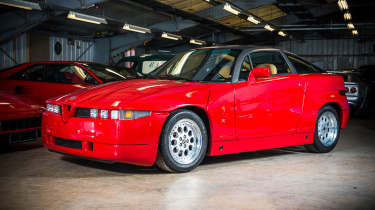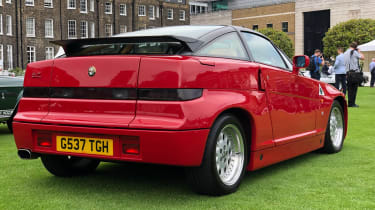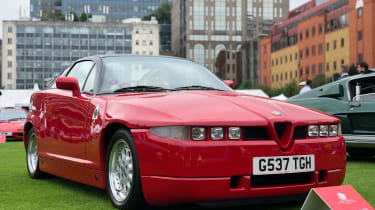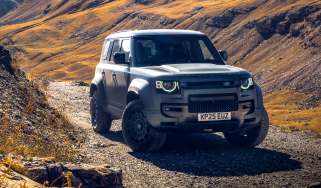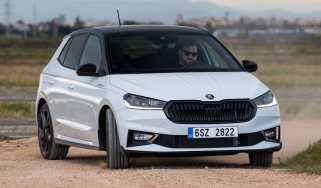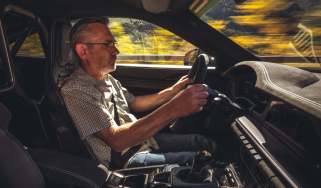Alfa Romeo SZ: history, review and specs of an icon
Alfa’s SZ might not have been universally praised for its looks, but with age it’s becoming increasingly desirable
Picture northern Italy in the late 1980s. Oversized shoulder pads, George Michael crackling out of period Blaupunkt car stereos and aged Alfasuds sharing Italian tarmac with knackered Cinquecentos, before they became ‘trendy’. Alfa Romeo was at a crossroads, past the golden age of the Giulia sprint, and about to enter the drudgery of 30-odd years of mediocre products.
With little in the range of much performance intent, out of nowhere Alfa Romeo showed something called the ES30 design study at the 1987 Geneva motor show. The Alfa Romeo SZ was born. Those of a younger disposition might know Alfa Romeo products to be attractive, but underwhelming to drive. Well, the SZ was the other way around. Affectionately nicknamed ‘Il Mostro’, Alfa Romeo’s Frankenstein shocked for many reasons, not least its brutalist styling.
> Click here to find out what Alfa Romeo have planned in the next 5 years
Priced from £35,000 in 1988 (around £65k in today’s money), the SZ’s exotica didn’t overcome its seemingly steep price tag, only a tail behind contemporary Porsche 911s and a hefty £5k more than a Lotus Esprit Turbo. As a result, only 100 were sold in the UK, although numbers have steadily risen over the years.
In detail
Many make the mistake of thinking the SZ was penned by Italian design house Zagato. Although Zagato did have a large input, the car was initially penned by Robert Opron of Alfa Romeo, part of a team headed by Walter de Silva at the time. A key design element that proves this theory is the lack of Zagato’s trademark double-bubble roof, a detail synonymous with Zagato’s designs.
More reviews
Group tests
- Lotus Emira Turbo SE v Alpine A110 GTS – two of the last surviving mid-engined sports cars
- Alpine A290 v Alpine A110 – how much DNA do they really share?
- Ariel Atom 4R v Caterham Seven ‘evo25’: power-to-weight heroes go head-to-head
- Ariel Atom 4 v Caterham Seven 310R v Lotus Elise Cup 250
- £200,000 supercar shoot-out: AMG v Aston Martin v Maserati v McLaren
- Audi Quattro, RS2 and RS3: five-cylinder icons head-to-head
- Who makes the best GT car? Aston Martin v Bentley v Maserati
- Caterham Super Seven 600 v Super Seven 2000
- Corvette Stingray v Porsche Cayman GTS v Audi R8 RWD
- GMA T.50 v McLaren F1 – has the best car in the world been dethroned by its successor?
In-depth reviews
- Abarth 600e 2025 review – Italy gives the Alpine A290 something to worry about
- Alpine A110 review – the sports car Lotus should be building
- Aston Martin Vantage 2025 review – a thrilling Mercedes-AMG GT and 911 Turbo S alternative
- Audi R8 (2015 - 2024) review – the ultimate soft-focus supercar
- Bentley Flying Spur review – the ultimate driver’s limousine
Long term tests
- Abarth 695C Turismo Fast Fleet test – living with the charming Italian hatch
- Alfa Romeo Giulia Veloce long term test – can Italy beat Germany?
- Alpina B10: Alpina B10: end of term report
- Aston Martin Vantage (2006) Fast Fleet test – living with a £30k V8 Aston
- Caterham Seven evo25 Fast Fleet test – living with a track car for the road
- Caterham Seven evo Edition revealed – bespoke 420R joins the Fast Fleet
- Cupra Leon 300 Fast Fleet test – living with Spain's 300bhp hot hatch
- Cupra Ateca VZN Fast Fleet test – four months with Cupra's hot crossover
- Cupra Leon Estate 310 4Drive Fast Fleet test – living with the 306bhp hot estate
- Ford Mustang GT
Review
- New Bentley Batur 2023 review – can it possibly be worth £1.65m?
- 2023 Chevrolet Corvette C8 Z06 review – the American 911 GT3?
- BBR Supercharged Mazda MX-5 (ND) 2023 review – tuned 250bhp roadster driven
- MG4 Trophy 2023 review
Reviews
- Abarth 695 75 Anniversario edition 2024 review – a fitting send-off for Abarth’s hot supermini?
- Abarth 500e 2023 review
- AC Cobra 378 Superblower MkIV 2021 review – another V8 Cobra, but with a GM heart this time
- Acura Integra Type S 2024 review – a Honda Civic Type R with added restraint
- Alfa Romeo Giulia review – get one while you still can
- Alfa Romeo 33 Stradale 2025 review – a rare Italian jewel beyond compare
- Alfa Romeo 1750 TBi
The styling has been a source of much controversy since its release, but one proposed theory for explaining the design was Alfa Romeo’s use of early CAD/CAM, or computer-aided design and manufacturing. In relying on computer-generated design in a time when a NASA supercomputer had less computing power than a modern fitbit, the challenging aesthetic is a little easier to comprehend.
From initial sketch, it took just 19 months for the SZ to reach production. Alfa Romeo contracted Zagato to build it in its Terrazzano di Rho facility, which is how the SZ received its association with the brand.
Built from a steel skeleton wrapped in composite body panels, the SZ’s body of components seems exotic today, but it was, in fact, mostly made up of a combination of road and race car components from within Alfa Romeo, further calling into question its extortionate asking price.
Forming the SZ’s backbone was a chassis derived from Alfa Romeo’s 75 Group A touring car racer. To fit, the 3-litre ‘Busso’ V6 engine was mounted longitudinally, and powered the rear wheels through a transaxle-mounted five-speed manual gearbox. Producing 207bhp at a creamy 6200rpm, the SZ might have cost nearly £15k more than a contemporary E30 BMW M3, yet would struggle to keep one in sight on the road.
Still, like so many cars of this age, the outright performance ceases to matter quite as much as the experience along the way. Regardless of whether the ‘Busso’ was a mainstream engine or not, its staggering soundtrack was enough to get even the biggest Alfa Romeo cynic hot under the collar
After the SZ’s run of 1036 cars, Alfa Romeo started producing the RZ Roadster. Although based on identical running gear to the SZ, it only shared the front wings with the coupe. Zagato was again called on to build the models, but production ground to a halt after 278 units due to financial issues.
Specs
| Engine | V6, 2959cc |
| Max power | 207bhp @ 6200rpm |
| Max torque | 181lb ft @ 4500rpm |
| Weight | 1260kg |
| Power-to-weight | 164bhp/ton |
| 0-62mph | 7.0sec (claimed) |
| Top speed | 152mph (clamied) |
| On sale | 1989-1993 |
| Price new | £35,000 (1988) |
What we said:
“Glancing around the cabin, the switches and light on the dash for the adjustable Koni hydraulic dampers mark out the SZ as something else. Test drivers reportedly achieved 1.4G in corners, but there’s no chance of that today (SZs are notoriously tricky in the wet), and although the 207bhp V6 is as sonourous as you’d expect, the overall impression after 20 minutes around the lanes is one of an old-fashioned saloon car. Which makes it even more of a cold slap in the face when you get out and look at the futuristic bodywork” - Henry Catchpole - evo 140

